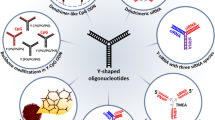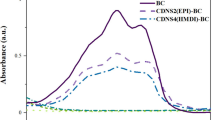Abstract
Cyclic phosphoester monomer ethyl ethylene phosphate (EEP) modified poly(ethylenimine) (PEI), denoted as PEI-EEP, was developed for gene delivery. Three PEI-EEP polymers were synthesized and their structures were characterized by 1H and 31P NMR methods. All the PEI-EEP polymers could condense DNA efficiently at N/P ratios higher than 0.5/1. The physiochemical characteristics of PEI-EEP/DNA complexes were analyzed by particle size and zeta potential measurements. The particle sizes of complexes were around 160–250 nm, and their zeta potentials were around 30–45 mV at the N/P ratios ranging from 10/1 to 50/1. In vitro cell viability and transfection ability were evaluated in HEK293 and HeLa cells using PEI as the control. The cytotoxicity of PEI-EEP and PEI-EEP/DNA complexes was lower than that of PEI and its complexes with DNA. The transfection efficiency of PEI-EEP/DNA complexes was correlated to modification degrees with phosphoester. When the modification of phosphoester to PEI was moderate, the PEI-EEP1/DNA and PEI-EEP2/DNA complexes exhibited comparable or even higher transfection ability than PEI/DNA complex at its optimal N/P ratio in the absence of serum. However, transfection efficiency of PEI-EEP3 reduced dramatically. More importantly, the PEI-EEP exhibited higher transfection efficiency in the presence of 10% serum than that without serum. Therefore, PEI-EEP polymers may be attractive vectors for non-viral gene therapy.
Similar content being viewed by others
References
Felgner PL, Gadek TR, Holm M, Roman R, Chan HW, Wenz M, Northrop JP, Ringold GM, Danielsen M. Lipofection: A highly efficient, lipid-mediated DNA-transfection procedure. Proc Natl Acad Sci USA, 1987, 84(21): 7413–7417
Felgner PL, Ringold GM. Cationic liposome-mediated transfection. Nature, 1989, 337(6205): 387–388
Gao X, Huang L. A novel cationic liposome reagent for efficient transfection of mammalian cells. Biochem Biophys Res Commun, 1991, 179(1): 280–285
Baker A, Saltik M, Lehrmann H, Killisch I, Mautner V, Lamm G, Christofori G, Cotten M. Polyethylenimine (PEI) is a simple, inexpensive and effective reagent for condensing and linking plasmid DNA to adenovirus for gene delivery. Gene Ther, 1997, 4(8): 773–782
Godbey WT, Wu KK, Mikos AG. Poly(ethylenimine) and its role in gene delivery. J Controlled Release, 1999, 60(2–3): 149–160
Laemmli UK. Characterization of DNA condensates induced by poly(ethylene oxide) and polylysine. Proc Natl Acad Sci USA, 1975, 72(11): 4288–4292
van de Wetering P, Moret EE, Schuurmans-Nieuwenbroek NM, van Steenbergen MJ, Hennink WE. Structure-activity relationships of water-soluble cationic methacrylate/methacrylamide polymers for nonviral gene delivery. Bioconjug Chem, 1999, 10(4): 589–597
Borchard G. Chitosans for gene delivery. Adv Drug Deliv Rev, 2001, 52(2): 145–150
Haensler J, Szoka FC Jr. Polyamidoamine cascade polymers mediate efficient transfection of cells in culture. Bioconjug Chem, 1993, 4(5): 372–379
Bielinska AU, Kukowska-Latallo JF, Baker JR Jr. The interaction of plasmid DNA with polyamidoamine dendrimers: Mechanism of complex formation and analysis of alterations induced in nuclease sensitivity and transcriptional activity of the complexed DNA. Biochim Biophys Acta, 1997, 1353(2): 180–190
Zinselmeyer BH, Mackay SP, Schatzlein AG, Uchegbu IF. The lower-generation polypropylenimine dendrimers are effective gene-transfer agents. Pharm Res, 2002, 19(7): 960–967
Boussif O, Lezoualch F, Zanta MA, Mergny MD, Scherman D, Demeneix B, Behr JP. A versatile vector for gene and oligonucleotide transfer into cells in culture and in vivo polyethylenimine. Proc Natl Acad Sci USA, 1995, 92(16): 7297–7301
Zintchenko A, Philipp A, Dehshahri A, Wagner E. Simple modifications of branched PEI lead to highly efficient siRNA carriers with low toxicity. Bioconjug Chem, 2008, 19(7): 1448–1455
Akinc A, Thomas M, Klibanov AM, Langer R. Exploring polyethylenimine-mediated DNA transfection and the proton sponge hypothesis. J Gene Med, 2005, 7(5): 657–663
Kircheis R, Wightman L, Wagner E. Design and gene delivery activity of modified polyethylenimines. Adv Drug Deliv Rev, 2001, 53(3): 341–358
Mintzer MA, Simanek EE. Nonviral vectors for gene delivery. Chem Rev, 2009, 109(2): 259–302
Petersen H, Fechner PM, Martin AL, Kunath K, Stolnik S, Roberts CJ, Fischer D, Davies MC, Kissel T. Polyethylenimine-graft-poly (ethylene glycol) copolymers: Influence of copolymer block structure on DNA complexation and biological activities as gene delivery system. Bioconjug Chem, 2002, 13(4): 845–854
Petersen H, Kunath K, Kissel T, Martin AL, Stolnik S, Roberts CJ, Davies MC. Star-shaped poly(ethylene glycol)-block-polyethylenimine copolymers enhance DNA condensation of low molecular weight polyethylenimines. J Controlled Release, 2003, 87(1–3): 286–288
Park MR, Han KO, Han IK, Cho MH, Nah JW, Choi YJ, Cho CS. Degradable polyethylenimine-alt-poly(ethylene glycol) copolymers as novel gene carriers. J Controlled Release, 2005, 105(3): 367–380
Swami A, Kurupati RK, Pathak A, Singh Y, Kumar P, Gupta KC. A unique and highly efficient non-viral DNA/siRNA delivery system based on PEI-bisepoxide nanoparticles. Biochem Bioph Res Co, 2007, 362(4): 835–841
Liang B, He ML, Xiao ZP, Li Y, Chan CY, Kung HF, Shuai XT, Peng Y. Synthesis and characterization of folate-PEG-grafted-hyperbranched-PEI for tumor-targeted gene delivery. Biochem Bioph Res Co, 2008, 367(4): 874–880
Thomas M, Klibanov AM. Enhancing polyethylenimine’s delivery of plasmid DNA into mammalian cells. Proc Natl Acad Sci USA, 2002, 99(23): 14640–14645
Forrest ML, Meister GE, Koerber JT, Pack DW. Partial acetylation of polyethylenimine enhances in vitro gene delivery. Pharm Res, 2004, 21(2): 365–371
Doody AM, Korley JN, Dang KP, Zawaneh PN, Putnam D. Characterizing the structure/function parameter space of hydrocarbon-conjugated branched polyethylenimine for DNA delivery in vitro. J Controlled Release, 2006, 116(2): 227–237
Xiao CS, Wang YC, Du JZ, Chen XS, Wang J. Kinetics and mechanism of 2-ethoxy-2-oxo-1,3,2-dioxaphospholane polymerization initiated by stannous octoate. Macromolecules, 2006, 39(20): 6825–6831
Benns JM, Choi JS, Mahato RI, Park JS, Kim SW. pH-sensitive cationic polymer gene delivery vehicle: N-Ac-poly(L-histidine)-graft-poly(L-lysine) comb shaped polymer. Bioconjug Chem, 2000, 11(5): 637–645
Ashkenazi N, Zade SS, Segall Y, Karton Y, Bendikov M. Selective site controlled nucleophilic attacks in 5-membered ring phosphoester esters: unusual C-O vs. common P-O bond cleavage. Chem Commun, 2005, (47): 5879–5881
Wang DA, Narang AS, Kotb M, Gaber AO, Miller DD, Kim SW, Mahato RI. Novel branched poly(ethylenimine)-cholesterol water-soluble lipopolymers for gene delivery. Biomacromolecules, 2002, 3(6): 1197–1207
De Smedt SC, Demeester J, Hennink WE. Cationic polymer based gene delivery systems. Pharm Res, 2000, 17(2): 113–126
Kichler A. Gene transfer with modified polyethylenimines. J Gene Med, 2004, 6: S3–S10
Sun YX, Xiao W, Cheng SX, Zhang XZ, Zhuo RX. Synthesis of (Dex-HMDI)-g-PEIs as effective and low cytotoxic nonviral gene vectors. J Controlled Release, 2008, 128(2): 171–178
Wiradharma N, Khan M, Tong YW, Wang S, Yang YY. Self-assembled cationic peptide nanoparticles capable of inducing efficient gene expression in vitro. Adv Funct Mater, 2008, 18(6): 943–951
Wen YT, Pan SR, Luo X, Zhang X, Zhang W, Feng M. A Biodegradable low molecular weight polyethylenimine derivative as low toxicity and efficient gene vector. Bioconjug Chem, 2009, 20(2): 322–332
Goldman CK, Soroceanu L, Smith N, Gillespie GY, Shaw W, Burgess S, Bilbao G, Curiel DT. In vitro and in vivo gene delivery mediated by a synthetic polycationic amino polymer. Nat Biotechnol, 1997, 15(5): 462–466
Sato T, Ishii T, Okahata Y. In vitro gene delivery mediated by chitosan. Effect of pH, serum, and molecular mass of chitosan on the transfection efficiency. Biomaterials, 2001, 22(15): 2075–2080
Wang YC, Tang LY, Li Y, Wang J. Thermoresponsive block copolymers of poly(ethylene glycol) and polyphosphoester: Thermo-induced self-assembly, biocompatibility, and hydrolytic degradation. Biomacromolecules, 2009, 10: 66–73
Author information
Authors and Affiliations
Corresponding author
Rights and permissions
About this article
Cite this article
Du, J., Tang, L., Yuan, Y. et al. Phosphoester modified poly(ethylenimine) as efficient and low cytotoxic genevectors. Sci. China Chem. 54, 351–358 (2011). https://doi.org/10.1007/s11426-010-4210-x
Received:
Accepted:
Published:
Issue Date:
DOI: https://doi.org/10.1007/s11426-010-4210-x




